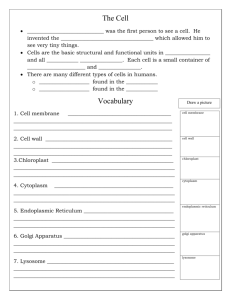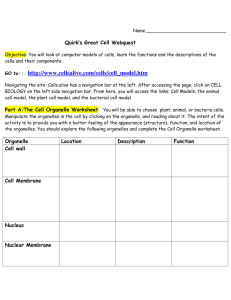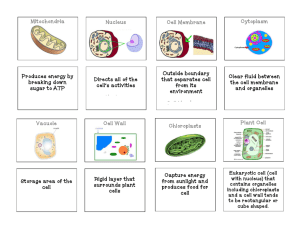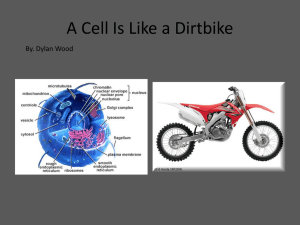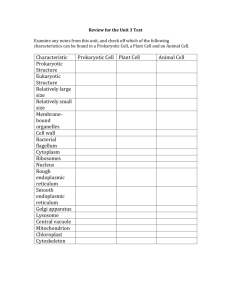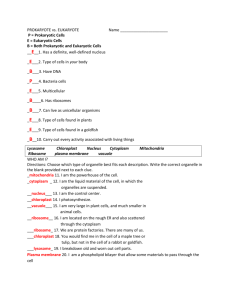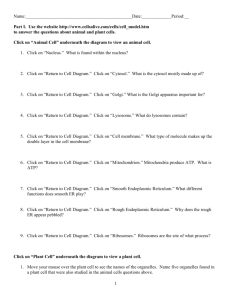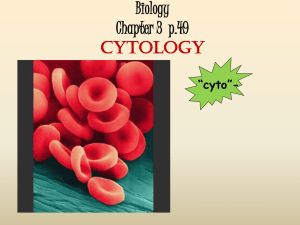Chapter 4 Study Packet
advertisement
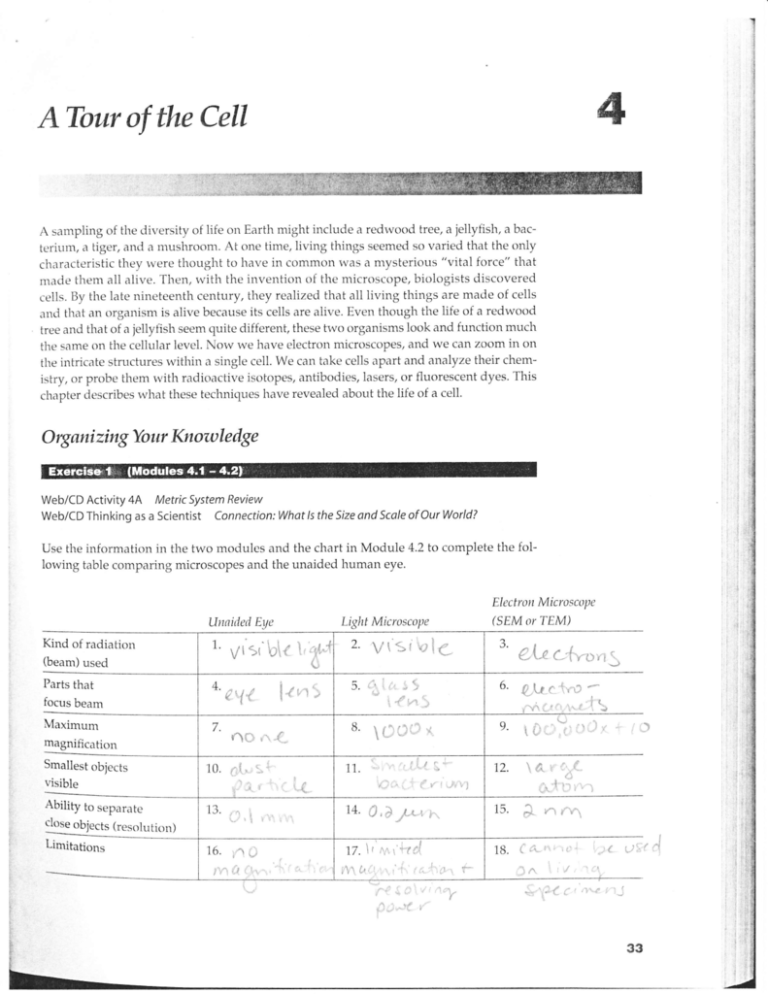
ATbur of the Cell
"-*:
A sampling of the cliversity of life on Earth might inclucle a redr,vood tree, a iellyfish, a bacterium, a tiger, anc{ a mushroom. At one time, living things seemed so varied that the only
ciraracteristic they were thought to have in common lvas a mysterious "vital force" that
macle them all alive. Then, lvith the invention of the microscope, biologists discovered
cells. By tire late nineteenth century, they realized that all living things are macle of cells
ancl that an organism is alive because its cells are alive. Even though the life of a redwood
tree and that of a jellytish seem quite different, these two organisms look and function much
the same on tire cellular level. Now we have electron microscopes, and we can zoom in on
tire intricate structures within a single celi. We can take cells apart and analyze their chemistry, or probe them with radioactive isotopes, antibodies, lasers, or fluorescent dyes. This
chapter describes what these techniques have revealed about the life of a cell.
,t
',
.:
;l
O tg ani
zing Your Knowle dge
.1
1
!
;
i
rl
'i
Web/CD Activity
4A
Web/CD Thinking as a
I
Metric System Review
1
Scientist Connection: What ls the Size and
I
Scole of Our Woild?
I
{
I
t{
Use the information in the two moclules and the chart in Module 4.2 to complete tire following table comparing microscopes and the unaided human eye.
tg
;
!
i
ji
'i
Electron Microscope
Light Microscope
Unaided Erle
Kind of radiation
1
(beam) used
Parts that
n'
7.
magnification
,".1
2. \,'I '-,
i
i
I
.)_
{ Irr t
I
.,-
-- - \ - i. I ,-, i
L,
.i
1
I
t
-1
,-'{i'
11,-
i t"
6. i I,f ,:, ' , ,li, -,
5.
r(
.:
8. \i
f.
fl
Ij
I
{
4
i
I
ir,
x
J
!
i
Smallest objects
visible
10.
Ability to separate.
13.
1a
I L-
11
q
'l
. :
{
I
!
close objects (resolution)
Limitations
1r' Ui i
|
i
(SEMoTTEM)
:l
focus beam
Maximum
ru.rl
.,
.l
14. ,y.
r
i_1
15. l:
I
i."',
I
, ,.
i
I
I
16.
18. i.:-I
/' ')
ri
,i
,;
T
I
I
J
4
e
N
t
{
t
.n
il
i.
I
ts-I'
33
,*.:
tI
\
34
Chapter 4
web/cD Thinking as a scientist connection: whot rs the
size ond
scare of
our worrd?
we need to use a microscope to see cells because cells
are so small. why can,t
a cell be as
big as a house, or at least as big as a baseball? Compare
the two cells diagrammed below.
For each cell, calculate the surface area, volume,
and ratio of surface area to volume.
Then answer the questions.
/
B I,m
/
/
4um
/
I
;
t
rs-
*
I
+4pm->
Cell
+--Bt..._
l
Cell2
7Grr,..
Surface area: s = 6 x (l x l)
=
Volume:
a=lxlxl=
#.,
Surface area: s = 6
Volume:
Surface/vol ume: s/u =
x
(/ x /) =
u=lxlxl= li
Surface/volume: s/a
=
1
lr
0-
.. l,
r
1. Which cell has the greater surface area?
{oLi
2. Which
-
cell has the greater volume?
,-r,
(.- -/-
'
i
3. Which cell has the greater ratio
i,rt{
4'
i}
[/'-
'
of surface area to volume?
j
In which cell would the surface
area of the membrane most efficiently
service the cytoplasm?
A Tour of thtt Cell
Web/CD Activity
4B
prokaryotic Cell Structure and Function
Bacteria and archaea consist of small, simple prokaryotic cells. Label
the following on this
diagram of a prokaryotic ceil: capsure, ceil wall, plasma membrane, nucleoid
region,
ribosome, prokaryotic flagella, pili. Briefly state the function of each
structure next to
its label.
.r\'*iu
*'o*}"r.-*='
.-n\d
aB
*l
r
,^**\ {-.**
\
!
t9ar
Y,{t
{
, /{ , l,\'
1
35
36
Chapter 4
4B Prokaryotic CellStructure and Function
4C Comparing Prokaryotic and Eukaryotic Cells
Activity 4D Build an Animal Cell and o Plant Cell
Web/CD Activity
Web/CD Activity
Web/CD
Examine the diagrams and text, and then compare the structures of the cells of prokaryotes,
plants, and animals by checking off their characteristics below. You may want to revise or
refer to this cl"recklist as you complete the chapter.
Charqcteristic
Proknryote CelI
Plsnt Cell
Arilmal Cell
Prokaryotic structure
Eukarvotic structure
Relatively Iarge size
Relatively small size
Membranous organelles
Plasma membrane
Cell wall
Cytoplasm
Ribosomes
Bacterial flagellum
Nucleus
Rough endoplasmic reticulum
Smooth endoplasmic reticulum
Golgi apparatus
Lysosome
Peroxisome
Mitochondrion
Chloroplast
Central l,acuole
Cytoskeleton
Flagellum
Centriole
L/'
A'['ottr of tlrc Cell
Web/CD Activity
Web/CD Activity
4E
4F
Overview of Protein Synthesis
The Endomembrane System
Ilcvie'n, the nucleus and the varions structures thtrt make up the c-nclot-uembr;rne system bv
uratciring each phrase on the right with a strLlcture from t1're list cxr the left. Anslvers crtn
be usecl more tlran once.
A. Nucletts
D
Tri,rnsport vesicle
C. Central vacuole
D. Smooth ER
E. Lysosome
F. Golgi apparatus
)-
IJ.
Cl.
Ilough ER
H. Contractile vacuole
I. llibosome
?
1. Lipicls manufactured here
Small strLrctrrre that makes protein
Contains chromtrtin
_f,_
L
Sac of enzymes that digest things
Carries secretions for erport from cell
D
Breaks dorvn cirugs and toxins in iiver
Makes cell membranes
Cell control center
_a_
b
Numerous ribosomes give it its name
"Ships" products to plasma mentbrane, outsirle, or other organelles
EU 11 . May store water, needecl cl'remicals, w,astes, pigments in plant cell
12. Buds off from Golgi apparatus
L
: (r\ 13. Defective in Pompe's clisease and Tay-Sachs disearse
14. Proteins rnade ancl modified here for secretiorl from cell
l+
15. Pumps out excess water frorn some cells
1 6. Nonmen-rbranous organelle
?
17. Takes in transport vesicles from ER and moclifies their contents
?
k 18. Digests food, wastes, foreign substances
19. Surrouncled by double layer of membrane with pores
20. How proteins, other substances get from ER to Golgi apparatus
21. Stores calcium in muscle cells
D
22. Marks and sclrts molecules to be sent to ciifferent clestinations
't /
-b
G
2.
3.
4.
5.
6.
7.
8.
9.
10.
-tr
L
E
_b
-T
E
23. Bucls off
lysosomes
,X
f,",,
w
38
Chnpter 4
Web/CD Activity
Web/CD Activity
4E
4F
Overuiew of protein Synthesis
The
Endomembrone System
sketch and laber the endomembrane system
on this diagram. Incrude rough ER, smooth
ER, ribosomes, Golgi apparatus, lysosome,
nuclear eivelope, transport vesicles, and
plasma membrane. (1) Trace the paih of
a protein from its site of manufacture
to the out_
side of the cell with a red arrow' (z) t.u."
?ne path of a protein i.co.po.ut"d into
a lysosome in blue' (3) Trace- the path of a protein
incorporated into the plasma membrane
in
green. (4) Trace the patr.r of a lipid secreted
from the ceil in t"ii;*.
{r'tt$&{-
Web/CD Activity
4G
+r,r,^y!l'[.{.,"1
I
euzfiLt
Build a Chloroptast and o Mitochondrion
Both mitochondria and chloroplasts
are energy converters, but their functions
are quite different. Compare them by filling in
the chart below.
Cliloroplost
Found in the follorving organisms
Carries out process
f,trnct,'o
Mitoclrondrion
15torui5 't-
r'"t. C,"ctl :1)
At-\ rr Pairtrcrir)
of.
ph ota s.i
Converts energy of
Into chemical energy in
S;,.t,'tM
nq-'it"-t's,
J
Ctitur
i
r,
r
{ rt'a :
AW
rt.xpi r c-\-t6:r
(k,
ATttttr of tlrc Cell
Web/CD Activity
4H
Cilia and Flagella
Cot.np.lre the components of the cvtoskeleton by inciicating rvith a checkmark r,vhich of
the' following trre char.rcte'ristics of microfil.ime.nts, intermec'iiate fil;rments, or microtubules.
Inte rrtrcditttc
Micrttfilrunauts
Filnnretrts
Milotttbttlcs
Hollon'tubes
Solir'l rocls
I(opelike structLrre
lvlade of tubulin
lVl.rcle of
tlbrotrs proteins
Hclp csli ch,rnge shape
Reinforcing rocls, anchor organeiles
Act in mr,rscle cell contraction
lvlove chromosomes
Act as tracks for organelle movement
Cive cell rigiclity, shape
ln cilia
ln flagella
In cerrtrioles
9
*
2 pattern
Dvnein arrts cause berrding movement
Web/CD Activity
4l
Cell
Junctions
lvlatch each of the cell surface
characte'ristics or structr-rres on the left
right.
jurrctitt.
|B. ]rglrt
PIasn-rorlesnr.r
C ,\,.r.h;;,*'n,.,.rinn
D. Cell r'all '5. Gap juncti.n
F' Extracellular m.ttrix
E
-L
&
with
a phrase on the
I
Clrannei betrvcen anim.rl cells
2. Rigid cellulose covering of plant cell
3. Lirrk animal cells in leakproof sheet
__S_ 4. Channel between plant cells
-C 5. Connects animal cells into a strong sheet
L 6. Sticky layer holcls animal cells together
39
40
Chapter 4
web/cD Activity 4J Review: Animar ceil structure
and Function
web/cD Activity 4K Review: prant ceil Structure and
Function
web/cD Thinking as a scientist Connection: How
Are space Rocks Anolyzed for signs of
Life?
Label the organelles listed in Module 4.19
on these diagrams of animal and plant
cells. (lf
you get stuck' refer toModule a'a)Try to group
your labels according to the functional categories in Module 4'19 so that you can circle
u.,a tuu"t each category. Complete your
diagrams by putting red boxes around the names
of structures fou^iin animal cells but
not in
most plant cells' Put green boxes around the
names of structures found in plant cells
but
not in animal cells.
Sq 65^ '{4 +'{ 11
A'lLtrrr
Tb
sting
Yo
ur Kn ow
Ie
dge
2. Which of the follow'ing
8. Cellular
uretabolism is
a. a type oi cell tlivisiorr.
b. the process by n,hicl"r certairr parts c.rllse
,.Sell to
d. mol,ement oi a cell.
e. control of tl-re cell by the nucleus.
9. Wliich of the followiug
cells?
a. olants .rnr-l animals
\-/
c
plants, fr.rngi, bacteri.r, aucl archaea
d. animals
e. plants, bacteria, and archaea
Organelles involved in energy conversion are
the
a. rough ER and Golgi apparatus.
b. nucleus and smooth ER.
c. nucleus and chloroplast.
d. lysosome and ribosome.
p.).l',ito.honclriou ancl chloroplast.
5.
The rnaximum size of a cell is limited by
pJt, n*c.t for cnough surface area for ex\_/
.
- clr.lnge
with its environment.
b. the ntimber of organelles that can be packed
insicle.
c. the rnaterials needed to build it.
d. the amount of t-lexibility it needs to be able
io t]t0ve.
e. the amorint of food it ueecls tcl survive.
6. You rvoulcl expect
a cell w,ith an extensive
Colgi apparatus tcr
2\nrakc.r loi of ATp.
(b)4....'tt.'
.r Iot ol' nrateri.rl.
c. move.tctirrelv.
q. pert()nn photrrsvnthesis.
e. stctrc l.rrge cl,rantities of fooci.
itlpor-
re \mooth ER
Vtr" Colgi apparatus
d. contractile vacuoles
e. rough ER
consist of prokaryotic
(0\f.,.tu.in and archaea
stores calcittt'u,
tant in muscle contraction?
a. mitochondria
e. f-h.ricl betrveen the organelles
3. Which of the following
a
i-r'lestnr t't."
\-/
A"a ribosome
4.
"se'l
(c.,)ne cltemical .rctivity of a ct'll.
rvould rof be consirl-
r.retl part of a cell's cytoplasrn?
Q.y'h" nrrcletrs
c. a mitochondrion
d. a microtubule
an
b. nucleus-cellu1ar respiration
c. ribosome-manufacture of lipirls
d. lysosorne-rnotcmerlt
(\entra I va cu ole-stor.'tgt'
through
a. a microtubule.
c. a ribosome.
d. the rrucleus.
(grJt he plasnr,r metnbratrc.
41
organelle rvith its functior-r?
a. mitochondriorr-photosyntiresis
To c-nter or leave tr cell, substances rnust pass
b. the Colgi apparatus.
Ccll
7. Which oi the follor,ving correctly m.rtches
Multiple Choice
1.
oitlr
10. Of the following organelles, n hich group is involved in manufacturing substances needed by
the cell?
a. lysosonre, vacuole, ribosome
16).iuoto*e, rorrgh ER, smooih ER
Y vacuole, ror-rgh ER, snrooth ER
d. smooth ER, ribosome, vacuole
e. rough ER, lysosome, vacuole
11.
f\e
internal skeleton of a cell is composecl of
intermediate tjlaments, ancl
(i. h-,i.rot.rUules,
\_-/
mrcrotrlarnents.
b. cellulose and intermediate liiirments.
c. cellulose, microtttbules, and centrioles.
d. microtilaments.
e. microtilaments and cellulose.
Essay
1.
What are the advantages of an electron micro-)(/5D\u"'\1
scope over a light rnicroscope? For rvhat tasks po '*t'r
would it be prefer;rble to use tr light microscope? u,k 1 -
2. Briefl y describe ttre .rajor
ctif
f
ere.ces b",X)iS "
"J#i{.^,
.
orok.rrvotic arrr{ cukarvotic eells.
's,rrLzl I S r n-ra\c. I a c ic qv t (tw s, + (o
e''rrw'-;ral t zt il
"*f
N.rtne [he stiircttrres Prcscnt irr plant cells htrt Otp*-t-L; t.
U
lacking iu anirnal celis,.rnd descrilre their
r
3.
functions. LeLl waLLs, Chto'oglasB,
Ct
n'frzut /t!cuJ\{)
42
Chapter 4
4. Explain the advantages
eukaryotic cells derive
from being compartmentalized by many inter_
-
is a cell,s ,,control center,,, and
chloroplasts its "solar collectors,,, which of the
following might be called the cell,s combina_
lion "food processor', and ,,garbage disposer,,?
(3./lysosome
b. Golgi apparatus
c. flagellum
d. ribosome
e. nucleolus
5. If the nucleus
nal membranes. -5ep67 tla yyvt-ta-ac i ic po c sl'rS r,uik;,; ti,f{. Co,,d,\<;.> Jot v'r41 -ora-f i,ago.,^,
5. Compare the functions of chloroplasts and 1n1-s,'^"ita-
tochondria in
a
tWa:sLV
plant cell.
Chtprrz" tr-Vtuyc
Lv\tti/'t2"
tc'Vi-v. tig\^I
tig\^1 ) Soctdrrr
S,.;cfrr,v'or.1 s,!)
vn,ftrch - co,lvr;1 i%:r -, '-A-nr
App ly i"S Yo ur Kno dt e Age
6.
Multiple Choice
1. A cell has mitochondria,
ribosomes, smooth
other parts. Based on this information,
IR, T9
it could rrot be
a. a cell from a pine tree.
b. a grasshopper cell.
c. a yeast (fungus) cell.
Qyhicrotubules.
c. smooth and rough ER.
d. mitochondria.
e. microfilaments.
@la bacterium.
e. Actually, it could be any of the above.
2. Dye injected
into a cell might be able to enter
an adjacent cell through a
"Prokaryotes are so small.
c. prokaryotes move so quickly they are hard
to photograph.
the cell
would
a. swell up and burst.
|..rn out of energy needed for its activities.
(g,bo o,rt of control.
d. not be able to absorb light.
e. divide immediately.
made an interesting obsen ation
about a protein made by the rou-gh ER and
eventually used to build a cell,s plasma mem_
brane. The protein in the membrane was actu_
ally slightly different from the protein made in
the ER. The protein.n as probably changed in
rbe
QGolgi apparatus.
b. smooth ER.
c. mitochondrion.
d. nucleus.
e. chloroplast.
The electron microscope has been particularly
^-rcell
(b.
c. vacuole.
/-T \
($,Plasmodesma.
e. lysosome.
4. A researcher
7.
useful in studying prokaryotes, beiause
a. electrons can penetrate tough prokaryotic
walls.
a. tight junction.
b. microtubule.
3. If a cell's chromatin were damaged,
When elongated, tube-shaped cells from the
lining of the intestine are treated with a certain
chemical, the cells sag and become round
blobs. The internal structures disrupted by this
chemical are probably
Acell junctions.
d. they aren't really alive, so it doesn,t hurt to
"kill" them for viewing.
e. their organelles are small and tightly packed
together.
8. A cell possesses ribosomes,
a cell
a plasma membrane,
wall, and other parts. It iould irol be
a. a bacterium.
b.ra cell from a fungus.
cell from a mouse.
d. an oak tree cell.
e. a bacterium or a cell from a pine tree.
(g
9. A mutant plant
cell unable to manufacture cel_
Iulose would be unable to
Gbulld
a ccll wall.
b. dir.ide.
c. capture sunlight.
d. move.
e. store food.
r\ I'otrr oi tltt' Ct'll
10. A prlant ccll n,as llr()\\'lr in .t test ttrbe contairring rarlioactivc trucleotirles, thc parts from
rr.hich I)\;\ is Lruilt. Later exi.utrin,rtion oi the
ccll shorvccl the r.rtlitlactivitl, ;11 br, concerr-
4. r\ poisor.r
th.rt acts sprecificallv orr miiochontiri.'r
n'as iounrl to interiere lvitli the movemutrt o[
cilia, slon, cion'rr pr1g[gin svnthesis, retluce thc.
irctluencY oi cell clivision, atrcl slorv rior.,,n the
rutarruf.rcture oi Iipids. i:xpl,rin htln, onc chemic.r1 cotrLl af ic.ct so rtrarrv r.liifcrerrt ceil iictivities.
traterl irr the
.r. rt,.ugh EIl.
b. C,olgi ..rpp.trattrs.
5. !Vhtn
c, :r.nooth ER.
43
vou rtork hirrtler, \,otrr nruscle ctlls
rr,ork h.trtler arrrl incre.rsr. ir.r size. I lorl, might
variotrs org.tnelles in a nrtisclc celi increase in
sizc, ntrnrbtr, or .tcti'u'itv trt respttnci to tlic chalIerrge of .rrr incrt.rsecl u,orkio.rc-l?
d. ct:ntral \,.rr'uole.
/\
t/Li.rcu\.
tr55dy
1. I xpl.rin rrhcthc.r
you u,ttuld use a light uricrosc()pe,,t transrtrission electron t'rricntscope
(TtrNI), ()r a scalltiug electrtn micrclscope.
(SIr\,1) to p'rcriorm cilch of the folloiviug tasks,
,rnr.i erplaiu \\1lty: examitring fine structur;rl clct.rils n,iihirr cell org.'rnclles, observing how, ,r
cell ch.tnges sh.rprg ;1s it moves, stuclyirre tinv
bumps orr thc ccll snrface, filming chtngts iu
the sltapre oi the I.utcletts as a ce,l1 prreptrrqs tit
Ext en d ilry Your Kn ow le dge
1. i\r.ralocics carr br, helprful in le,arning
ancl unclerstarrt'ling it lte\\, topic. For example, the cell
c.ur be tlror-rglit of as a chertrical f.rctory, and the
nnclttrs as its rnain office or cttrrtrol ce,nter. Can
conlpare the ftu-rctitlus tlf othc'r cell parts to
VOLI
the parts of a iactory? Wl-rat migl'rt be the factory rloors? The pcllver piant th.rt prrtr.icles energv for running the factory? The r,v.rrehouse
lr,itcre ral.r, rnaterials or protlucts are storecl?
Can you think of other con-rparisons? Horv
cloes the cell rliifc.r from a factory?
divitie.
2.
Im.rgine, a cell shapecl like a cube, 5 prm on each
side. (Cr.lls are not periect cubes, but tl.ris .rssnnrptiorr sirnplil:ies the question.) Wirat is the
snrfacr. c'rr€.fl ()f the cell, in prm2? What is its volrur-ne, in pm3? Wh,rt is the r;rtio of surface ;rrea
to volnt'rrr. for this cell? (Sketches may help.)
Norv imacine
.10
scColtcl cell, tiris one
llnl ol1
each sicle. Whitt are its sr-rrface arr.a, volume,
.rnci snrface-to-r,olume ratio? Comp.rre the
ct
snrface-to-r,olume ratios oi the two celis. Hor,v
is this comp.rrisou significirnt to tl-rc. fuuctioniue oi cells? FIrxv coulcl the surface-to-volurnc.
ratio ot: the l.trser cell be increasecl?
3'
r\n enzyrle (a type of protein) caliecl salivary
amylase is rlarrufactureci in tl-re cells of your
salivary gl.rntls antl secreted as part oI saliva.
Explain horv these parts clf the cell cooperate to
procluce ,tucl se-crcttl salit,ary amylasr.: transport vtsiclrs, r()ugh EI{, pl.tsm.-r me.rnbranc,
uuctcus, (,trlgi (lpparat[rs, ribosornes.
2.
Ilasic research is scier-rtit'ic investigation aimerl
at figr.rring out hovv sclrnetl.ring *,orks, lvithout
tiror-rght for the immediate usefulness of the inforrn.rtion obt.rinecl. Thc. goal clf appliecl research, orr the other hancl, is to pu1 scientitic
knou,leclge to r.vork. Mr,rch of cell biology is
b.rsic research-simply figurirrg out rvhat the
parts of a cell are and irow the-v vt,rtrk.
Neve.rtheless, the recent explosicln of knorvlerlge abotrt cells has becn immensely useful.
For e.xample, unrle,rstanding lysosome,s has
helpecl trs to understand rlisorders such trs TayS.rchs t'lisease. Can yorr think of other ex.lrrples
r,r,here' our urrclerstarrcling of cells h.rs mrtde our
live.s more. he.tiihy, conrfortable, or procltrctive?

